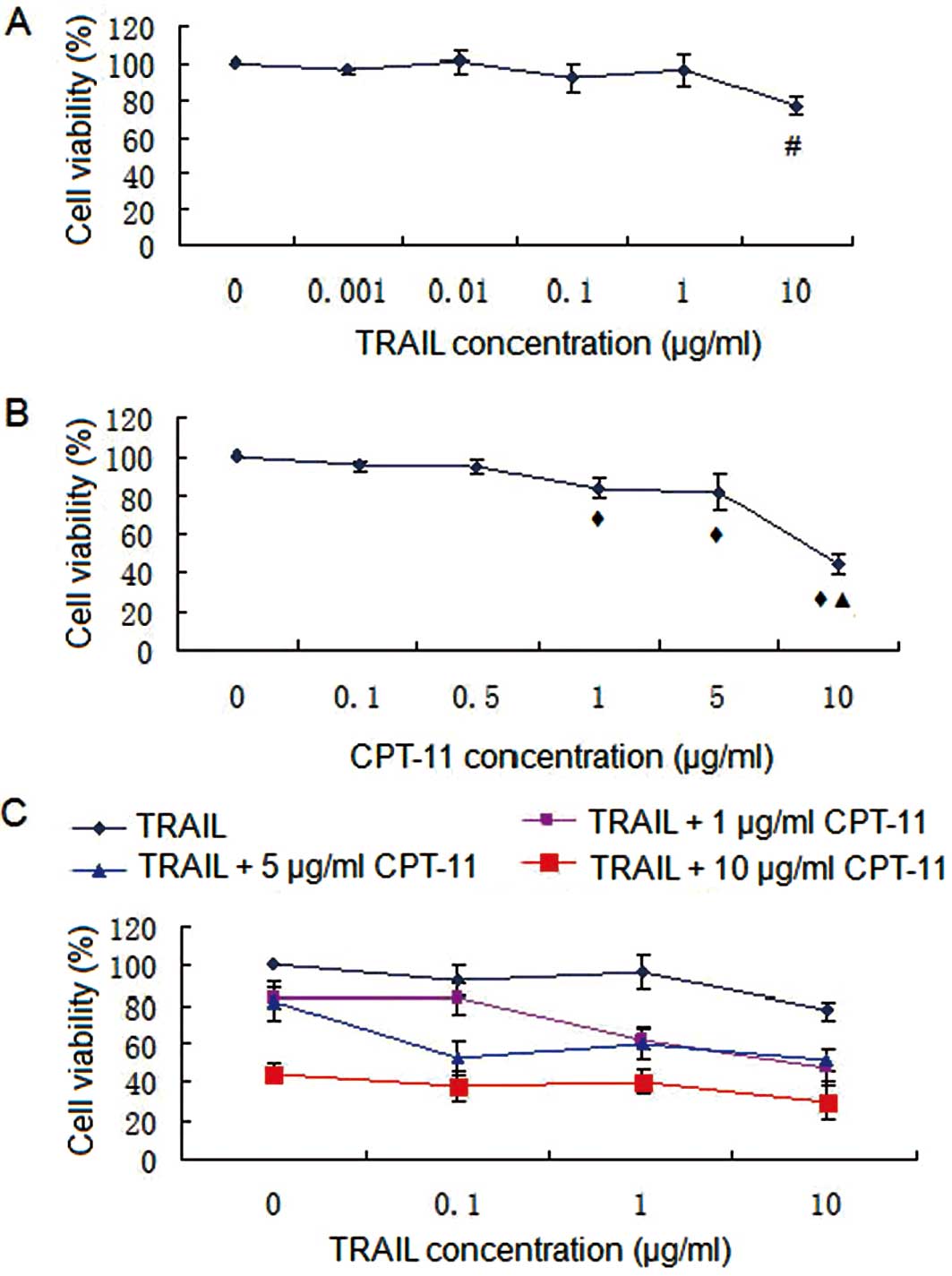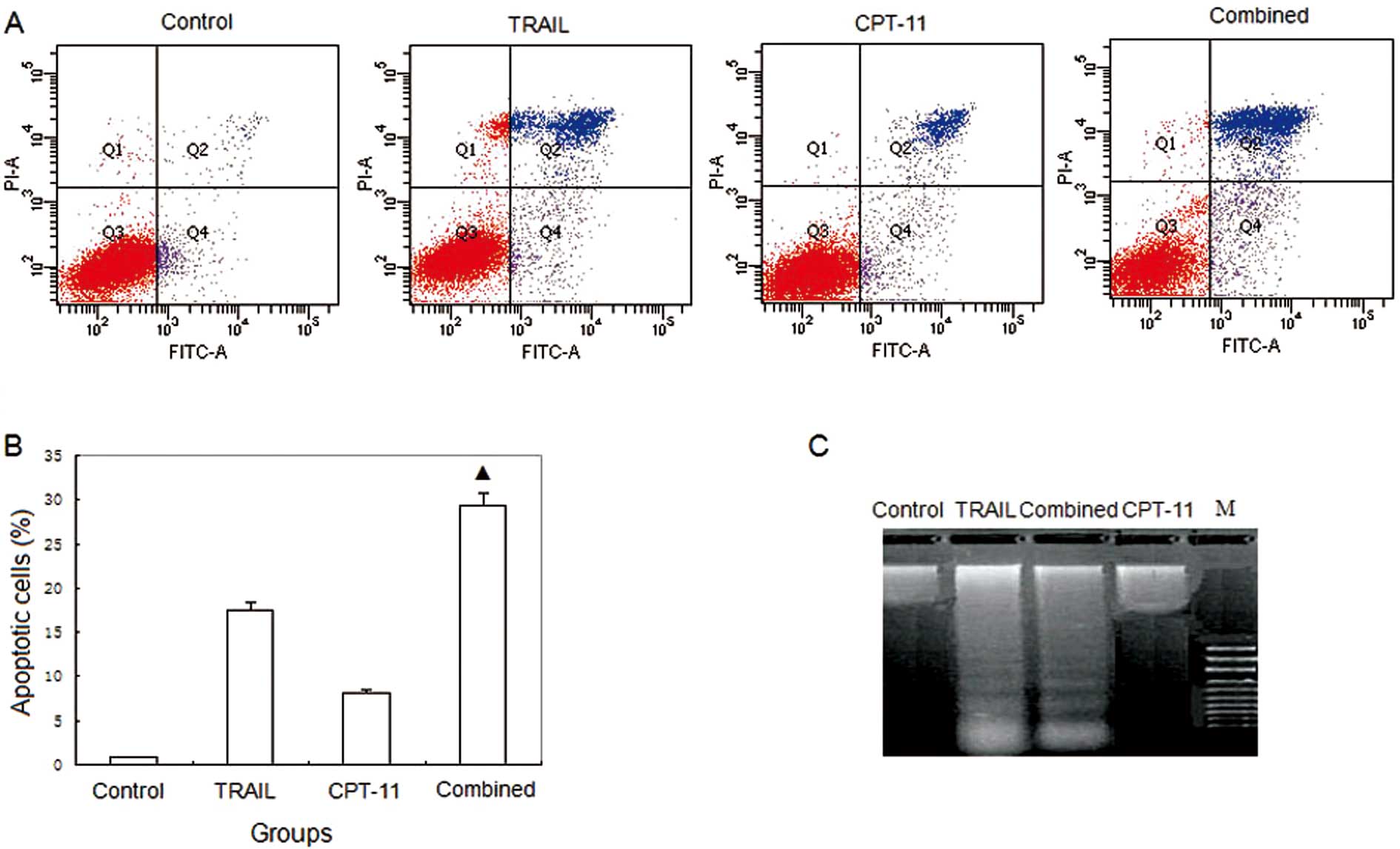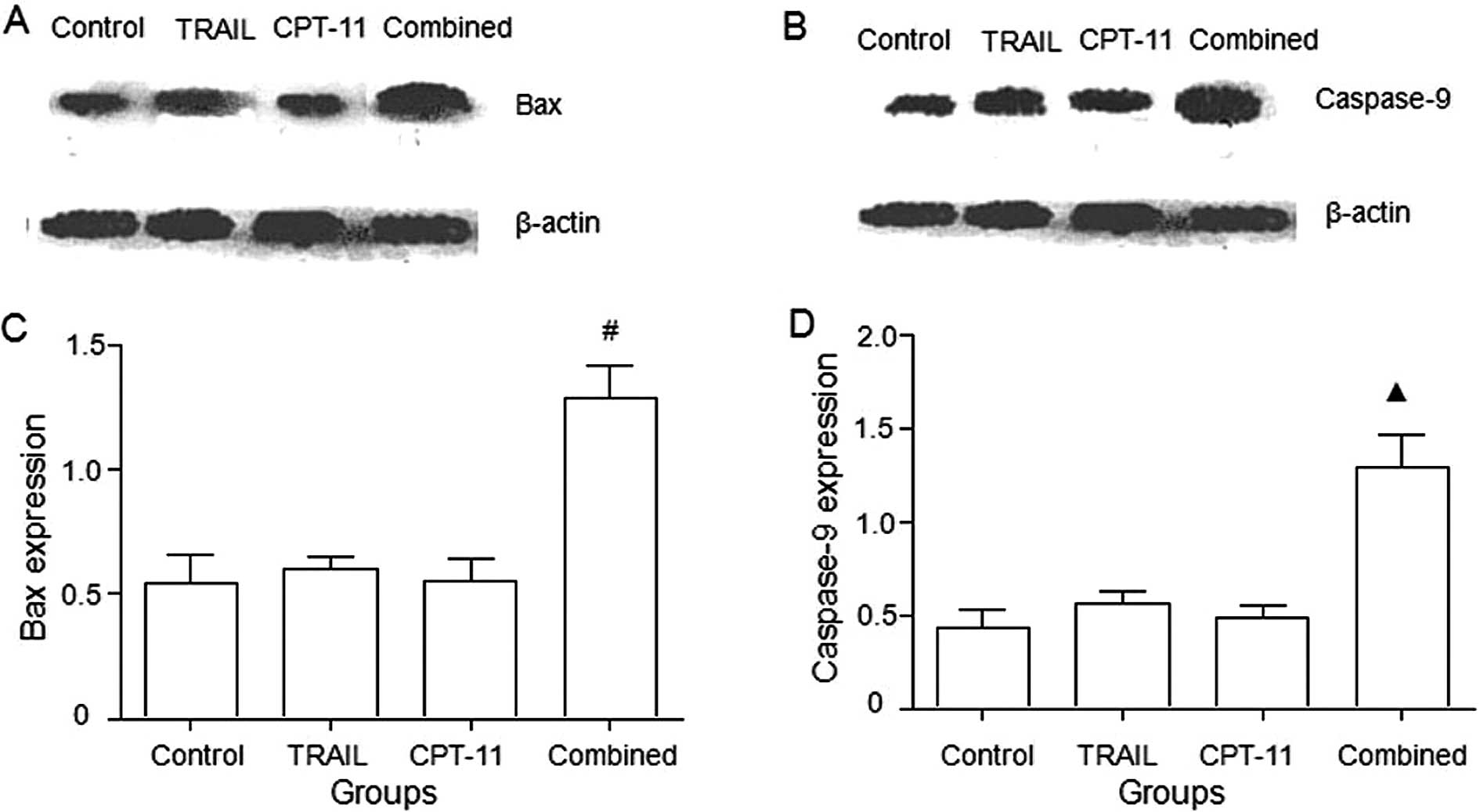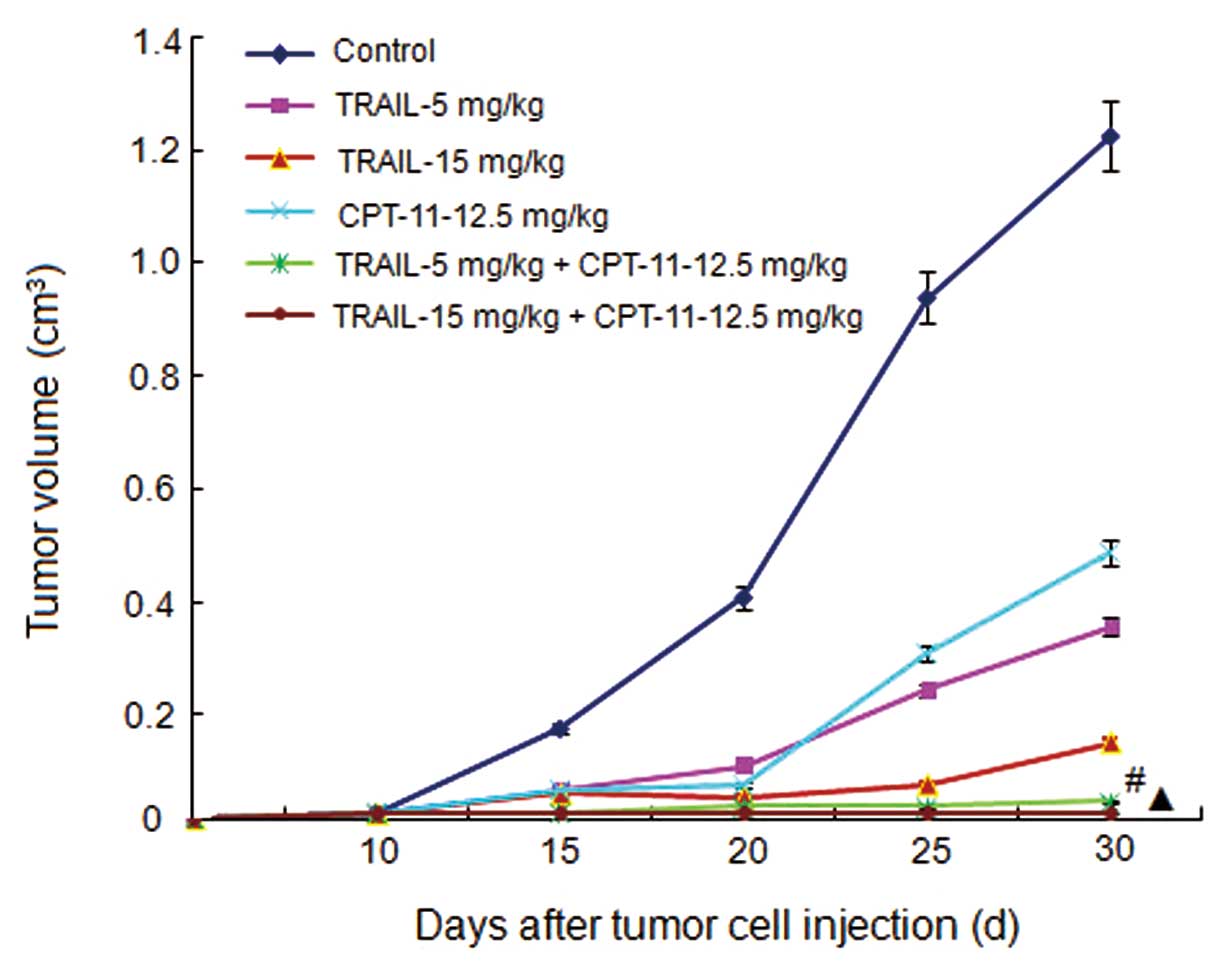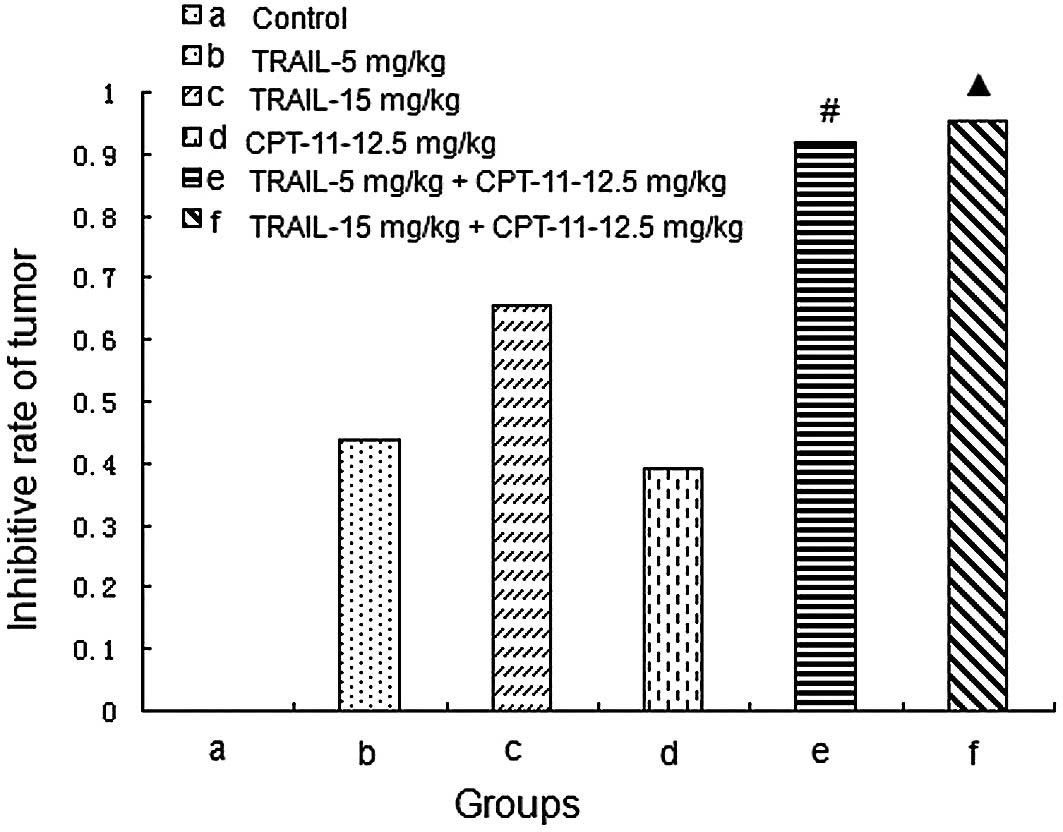The synergistic effects of low-dose irinotecan and TRAIL on TRAIL-resistant HT-29 colon carcinoma in vitro and in vivo
- Authors:
- Published online on: August 21, 2012 https://doi.org/10.3892/ijmm.2012.1105
- Pages: 1087-1094
Abstract
Introduction
Colorectal cancer is the most frequent malignancy of the digestive tract, and one of the most common types of solid organ cancer in both males and females in developed countries. Worldwide, approximately 1 million cases are recorded annually, and over half a million patients succumb to this disease each year (1). Irinotecan (CPT-11) is a topoisomerase I inhibitor widely used in the treatment of colorectal tumors (2). However, the use of CPT-11 in a clinical setting has been hampered by modest efficacy and significant toxic side-effects (3). Thus, novel treatment strategies are urgently needed to improve the clinical management of colorectal cancer.
Tumor necrosis factor-related apoptosis-inducing ligand (TRAIL), a tumor necrosis factor superfamily member has been shown to induce apoptosis. TRAIL can bind to 5 different receptors: TRAIL-R1 (death receptor 4, DR4), TRAIL-R2 (DR5), TRAIL-R3 (decoy receptor, DcR1), TRAIL-R4 (DcR2) and osteoprotegerin (OPG). DR4 and DR5 are the death receptors that signal for apoptosis, whereas DcR1, DcR2 and OPG are considered antagonistic as they are unable to induce such signaling due to the lack of intracellular death domain or are secreted molecules (4). TRAIL triggers apoptosis through binding to its receptors (DR4 and/or DR5) in a broad range of human cancer cell lines while sparing most normal cell types (5). Thus, TRAIL is a promising cancer therapeutic agent due to its tumor selectivity (6). Several studies have previously demonstrated that many colon carcinoma cells were sensitive to TRAIL both in vitro and in vivo except for HT-29 (7,8). They also found that CPT-11 enhanced the antitumor effects of TRAIL on HT-29 colon carcinoma (9). However, the focus was mainly on the TRAIL sensitive colon carcinoma cell lines such as COLO 205, SW948, and HCT116, and the synergistic effects of TRAIL and CPT-11 on HT-29 were not studied thoroughly (7). In this study, we investigated the combined effects of TRAIL and CPT-11 at different doses and explored the potential apoptosis mechanism on TRAIL-resistant HT-29 colon carcinoma cells in vitro and in vivo.
Materials and methods
Materials
Human HT-29 colon carcinoma cell line and TRAIL were provided by DIAO Group (China). Female nude mice (6 weeks old) were purchased from the animal experimental center of the Chinese Academy of Science, Shanghai (China). CPT-11 was purchased from Aventis (France). Sulforhodamine B (SRB) was supplied by Sigma (USA). Roswell Park Memorial Institute (RPMI)-1640 medium and trypsin were purchased from Gibco (USA). Mouse monoclonal antibody for Bax was purchased from Santa Cruz Biotechnology, Inc., (USA). Mouse monoclonal antibody for β-actin was purchased from Abcam (UK). Mouse monoclonal antibody for caspase-9 was purchased from Lab Vision (USA). LSAB kit was purchased from Dako (Japan). Goat anti-mouse IgG-HRP was purchased from Rockland (USA). TRIzol kit and apoptotic DNA ladder kit were purchased from Bioteke Corporation (China). One-step RT-PCR kit was purchased from Takara Biotechnology Co., Ltd., China. Polyvinylidene difluoride (PVDF) membrane was purchased from Millipore. Enhanced chemiluminescence (ECL) detection kit and X-ray film were purchased from Roche (Switzerland). Annexin V-FITC apoptosis detection kit was purchased from Jingmei Biotech Co., Ltd. (China).
Cell culture
The HT-29 colon carcinoma cell line was cultured in RPMI-1640 medium supplemented with 10% fetal bovine serum plus ampicillin and streptomycin routinely, and incubated in 5% CO2 at 37°C.
TRAIL and CPT-11-mediated toxicity
Cell viability was measured by the SRB method (10). Briefly, exponentially growing tumor cells were seeded in a 96-well plate (1×104/well). Cells were incubated without treatment for 24 and 72 h, respectively, in a negative control group 1 and 2. Adherent cell cultures were fixed in situ by addition of 45 μl of cold 50% (w/v) trichloroacetic acid (TCA) and were kept for 60 min at 4°C. The supernatant was then discarded, and the plates were washed 5 times with distilled water and air dried. In the TRAIL or CPT-11 alone group (cells treated with TRAIL or CPT-11 alone), cells were incubated for 24 h, and then TRAIL or CPT-11 was added to each well, respectively. The final concentrations of TRAIL were 0.001, 0.01, 0.1, 1 and 10 μg/ml, respectively. The final concentrations of CPT-11 were 0.1, 0.5, 1, 5 and 10 μg/ml, respectively. The cytotoxic effect was evaluated 48 h after drug challenge. Briefly, adherent cell cultures were fixed in situ by addition of 45 μl of cold 50% (w/v) TCA and were kept for 60 min at 4°C. The supernatant was then discarded, and the plates were washed 5 times with distilled water and air dried. SRB solution (0.4% w/v in 1% acetic acid) was added and the cells were allowed to stain for 10 min at room temperature. Unbound SRB was removed by washing 3 times with 1% acetic acid. The plates were then air dried. Bound stain was dissolved with unbuffered 10 mM Tris base [tris(hydroxymethyl)aminomethane]. The absorbance values of the solution in each well were measured at 490 nm using a microplate reader. Cell viability was measured by the formula: If Ti ≥ Tz, cell viability (%) = [(Ti-Tz)/(C-Tz)]x100; If Ti < Tz, cell viability (%) = [(Ti-Tz)/Tz]x100. (Ti, absorbance of the wells treated with TRAIL or CPT-11; Tz, absorbance of the wells in negative control 1; C, absorbance of the wells in negative control 2). All SRB experiments were performed in triplicate and repeated at least 3 times.
The concentrations of reagents that induced a 50% reduction in cell viability (IC50) were determined from curves of reagent concentration vs. cell viability at 48 h of incubation for the cell line analyzed. The sensitivity of cells to the drug was evaluated by the value of IC50. IC50 <10 μg/ml, indicated that the cells were sensitive to the drug, while IC50 ≥10 μg/ml, indicated that the cells were relatively resistant to the drug (11).
Combination of TRAIL and CPT-11-mediated toxicity
According to the effect of TRAIL and CPT-11 treatment alone on cell viability, the concentrations of the combination of TRAIL and CPT-11 were chosen as follows: TRAIL (0.1, 1 and 10 μg/ml, respectively), CPT-11 (1, 5 and 10 μg/ml, respectively). Cell viability was then assessed by SRB assay. Negative control group 1, negative control group 2, TRAIL alone group, CPT-11 alone group and combination group (cells treated with TRAIL and CPT-11) were designed for this experiment.
Evaluation of synergistic effect
The synergistic effect of the combination of TRAIL and CPT-11 was analyzed by the Webb coefficient (12). Predicted cell viability (c) was calculated according to the equation c = a x b/100, where a and b indicated cell viability with single agents. Synergism in drug interaction was indicated by observed cell viability of ≤70% of the predicted cell viability (11). According to the results of synergetic effect, the optimum concentrations of 0.1 μg/ml TRAIL and 5 μg/ml CPT-11 were chosen for later experiments in vitro.
DNA ladder assay
For detection of apoptosis by the DNA fragmentation assay, 2×106 cells were plated into culture dishes 24 h prior to drug treatment. Following treatment with TRAIL or CPT-11 for 48 h, HT-29 cells were washed with phosphate-buffered saline (PBS) and harvested. Cells were then resuspended in 0.5 ml of lysis buffer for 10 min at room temperature. After centrifugation at 12,000 rpm at room temperature for 5 min, the supernatant was transferred to a new Eppendorf tube and equal volumes of isopropanol were added, before centrifuging at 2,000 rpm at room temperature for 30 sec. DNA was acquired by centrifugation of the samples, washed, dried and dissolved in loading buffer, and separated by electrophoresis during 90 min at 60 V on 2% agarose gels, containing ethidium bromide (EB). Bands were visualised under ultraviolet light.
Flow cytometry analysis of apoptosis
To confirm that TRAIL- and CPT-11- mediated cell death occurs by apoptosis, we employed flow cytometry and determined the percentage of specific apoptotic cells. Apoptosis was quantified using the Annexin V-FITC apoptosis detection kit according to the manufacturer’s instructions. Briefly, exponentially growing tumor cells were first digested with 0.25% trypsin and counted. They were then diluted to a final concentration of 1×105 cells/ml and inoculated into a culture dish at 10 ml/dish. When 50–60% confluency was reached, cells incubated with 5 μg/ml CPT-11 or 0.1 μg/ml TRAIL alone or with the combination of both for 48 h were harvested by trypsin release, washed twice with cold PBS, and permeabilized with 70% ethanol in PBS for 30 min. Then they were resuspended in Annexin V binding buffer. FITC-conjugated Annexin V (1 μg/ml) and propidium iodide (50 μg/ml) were added to the cells and incubated for 15 min at room temperature in the dark before flow cytometry analysis. The samples were detected using an Elite-ESP flow cytometer (Beckman-Coulter, USA). A minimum of 104 cells were analyzed in each sample. All experiments were repeated at least 3 times.
Reverse transcription polymerase chain reaction (RT-PCR)
Total-RNA was extracted from cells using TRIzol reagent. The RNA was then quantified spectrophotometrically. RT-PCR was run using One-Step RT-PCR kit. The primers for DR4, DR5 and glyceraldehyde-3-phosphate dehydrogenase (GAPDH) were synthesized by Shanghai Genebase Gene-Tech Co., Ltd. (China). GAPDH was used as internal control primer. The upstream primers of DR4, DR5 and GAPDH were, 5′-CTGAGCAACGCAGACTCGCTGTCCAC-3′, 5′-GCCTC ATGGACAATGAGATAAAGGTGGCT-3′ and 5′-ACCAC AGTCCATGCCATCAC-3′, respectively. The downstream primers of DR4, DR5 and GAPDH were, 5′-ACAGCATCAG AGTCTCAGTGGGGTCAGC-3′, 5′-CCAAATCTCAAAGTA CGCACAAACGG-3′ and 5′-TCCACCACCCTGTTGCTG TA-3′, respectively. The PCR products were a 202-bp fragment for DR4, a 220-bp fragment for DR5, and a 485-bp fragment for GAPDH, respectively.
PCR was performed in a 25 μl reaction volume. PCR cycling conditions of DR4 were as follows: an initial denaturing step at 94°C for 2 min, 30 cycles repeating a denaturation step of 94°C for 10 sec, followed by an optimized annealing temperature of 59°C for 10 sec, and a final elongation step at 72°C for 20 sec. PCR cycling conditions of DR5 were as follows: an initial denaturing step at 95°C for 2 min, 30 cycles repeating 94°C for 10 sec, 52°C for 10 sec and 72°C for 20 sec.
Amplified products of DR4, DR5 and GAPDH were separated by 1.5% agarose gel electrophoresis in EB stained and viewed under ultraviolet light. The electrophoresis images were obtained and the DR4, DR5 and GAPDH band integrated optical density values were analyzed using the Bio-Rad image system. Semiquantitative analysis of DR4 and DR5 mRNA was performed by comparison to GAPDH.
Western blot analysis
Cells incubated with 5 μg/ml CPT-11 or 0.1 μg/ml TRAIL alone or in combination for 48 h were lysed in lysis buffer. Protein content of the supernatant was measured using the bicinchoninic acid (BCA) method. Cell lysate protein (25 μg) was separated by SDS-PAGE using a Trisglycine system and then gels were electroblotted onto PVDF membranes for 1.5 h. The membranes were then incubated with 5% non-fat dry milk in PBS for 1 h for blocking nonspecific binding sites, and then incubated with the appropriate primary antibody concentration (1:400 dilution for caspase-9 and Bax, and 1:2,000 for β-actin) for 1 h at 37°C in 5% non-fat dry milk. Membranes were subsequently rinsed in PBS, and then incubated for 1 h at 37°C with secondary antibody (horseradish peroxidase conjugated anti-mouse IgG at 1:2,000 dilution). Following incubation, membranes were rinsed and blots were visualized by incubation with ECL detection reagents. Signal density was obtained by scanning exposed X-ray films on a Bio-Rad imaging system. Normalized density was obtained by dividing the rough density values of a sample band over loading control band (β-actin).
Combined effects on HT-29 xenograft on nude mice
All animal procedures were approved by the Animal Care and Scientific Committee of Sichuan University. Thirty-six HT-29 bearing nude mice were divided into 6 groups (6 mice/group); the control group, treated with normal saline; the TRAIL-5 mg/kg group, treated with TRAIL with a concentration of 5 mg/mice weight (kg); the TRAIL-15 mg/kg group, treated with TRAIL with a concentration of 15 mg/mice weight (kg); the CPT-11-12.5 mg/kg group, treated with CPT-11 with a concentration of 12.5 mg/mice weight (kg); the TRAIL-5 mg/kg + CPT-11-12.5 mg/kg group, treated with TRAIL with a concentration of 5 mg/mice weight (kg) and CPT-11 with a concentration of 12.5 mg/mice weight (kg); the TRAIL-15 mg/kg + CPT-11-12.5 mg/kg group, treated with TRAIL with a concentration of 15 mg/mice weight (kg) and CPT-11 with a concentration of 12.5 mg/mice weight (kg). Saline was injected through the tail vein 15 times in 15 days; TRAIL was injected through the tail vein 5 times in 5 days, and CPT-11 was injected into the peritoneal cavity 6 times in 6 days. The length, width, and weight of the tumor were measured using a slide caliper every 5 days. Tumor volume (TV) was estimated using the formula: TV (mm3) = (width2 x length)/2. Inhibitive rate of tumor was calculated using the formula: inhibitive rate of tumor (%) = (1 - average weight in treated group/average weight in control) x 100% (13).
Statistical analysis
Results were expressed as the mean ± standard deviation (SD) with the exception of the tumor inhibitive rate. Statistical comparisons of mean values were analyzed by one-way ANOVA, followed by the Student’s t-test. Data of tumor inhibitive rate were analyzed using the Chi-square test. Linear correlation between cell viability and concentrations of CPT-11 or TRAIL was analyzed using SPSS 13.0 software. Synergetic effect was evaluated using the Webb coefficient. All P-values were 2-sided and P<0.05 was considered to indicate statistically significant differences.
Results
SRB assay
Results of the SRB assay are shown in Fig. 1 and demonstrate that TRAIL induced limited cell death, and there was significant negative correlation between cell viability and TRAIL concentration (r=−0.779, P<0.05). IC50 >10 μg/ml suggesting that HT-29 cells were relatively resistant to TRAIL. The cell viability of HT-29 cells treated with 10 μg/ml TRAIL was significantly higher than in 0, 0.01, 0.01, 0.1 and 1 μg/ml TRAIL groups (Fig. 1A). CPT-11 induced cell death in a dose-dependent manner (r=−0.863, P<0.05). IC50 was <10 μg/ml suggesting that HT-29 cells were sensitive to CPT-11. The cell viability of HT-29 treated with 1 μg/ml CPT-11 was significantly higher than in 0, 0.1 and 0.5 μg/ml CPT-11 groups, and the cell viability of HT-29 cells treated with 10 μg/ml CPT-11 was higher than in 0, 0.1, 0.5, 1 and 5 μg/ml CPT-11 groups (Fig. 1B). Webb coefficient analysis showed that only 0.1 μg/ml TRAIL combined with 5 μg/ml CPT-11 had a significant synergistic effect (P<0.05) (Fig. 1C and Table I).
DNA ladder assay and flow cytometry
DNA fragmentation was seen in the TRAIL and combined groups, but not in the other 2 groups (Fig. 2C). The apoptosis rates were 0.9, 17.5, 8.1 and 29.3%, respectively, in the control, TRAIL alone, CPT-11 alone, and combined group. There were significant differences of apoptosis rates in the combined group vs. the other groups (P<0.05) (Fig. 2A and B).
DR5 and DR4 mRNA expression
Compared with the control or TRAIL alone or CPT-11 alone groups, the combination of TRAIL and CPT-11 significantly upregulated the expression of DR5 mRNA in HT-29 cells (Fig. 3A and C), whereas DR4 mRNA in HT-29 cells showed no significant difference among the groups (Fig. 3B and D).
Bax and caspase-9 protein expression
As shown in Fig. 4, the combination treatment of TRAIL and CPT-11 significantly upregulated Bax and caspase-9 proteins (P<0.05).
Tumor growth curves and inhibitive rates of tumor growth
The treatment began on Day 10 after the injection of tumor cells. The tumor volumes were recorded every 5 days and the tumor growth curves were depicted. The tumor growth curves and inhibitive rates are shown in Figs. 5 and 6, respectively. The results show that the 2 combined treatment groups could inhibit the tumor growth significantly compared with the other groups (P<0.05).
Discussion
TRAIL induced apoptotic cell death in a variety of tumorigenic or transformed cell lines but not in normal cells (14). The selective killing of tumor cells by TRAIL has made TRAIL receptors attractive targets for cancer treatment. In preclinical models, recombinant soluble TRAIL demonstrated notable anticancer activity (15,16). However, an increasing number of studies have demonstrated TRAIL resistance in primary human tumor cells especially in those of solid tumor entities (17). Thus, novel treatment strategies are urgently required to overcome this resistance in tumor cells. Several reports have described the ability of subtoxic concentrations of chemotherapeutic drugs to sensitize tumor cells that are resistant to TRAIL (18). The antitumor properties of TRAIL can be significantly enhanced when used in combination with chemotherapy, as has been demonstrated in many studies using different tumor cell lines and mouse models (15).
In the present study, we focused on the synergistic effects of low-dose CPT-11 and TRAIL on the HT-29 TRAIL resistant colon cancer cell line. The SRB assay demonstrated that HT-29 cells were relatively resistant to TRAIL and sensitive to CPT-11. The antitumor effects of TRAIL could be significantly enhanced by a low-dose of CPT-11 on HT-29 cells. The DNA ladder assay and flow cytometry confirmed that low-dose CPT-11 could significantly enhance the apoptosis induction effects of TRAIL on HT-29 cells.
Previous studies showed that chemotherapeutic agents could increase the expressions of DR4 and DR5 in tumor cells (19). The upregulation of DR4 and DR5 enhanced the responsiveness of cells to TRAIL (20,21) and cell death was enhanced when these agents were combined with TRAIL (19). Our data showed that the combination of TRAIL and CPT-11 could upregulate the expression of DR5 mRNA in HT-29 cells, whereas DR4 mRNA in HT-29 cells showed no significant difference among the groups.
TRAIL-induced apoptosis appears to require expression of one or both of its death domain containing receptors DR4 or DR5 (14). In addition, DR4 and DR5 actively promote apoptosis upon TRAIL binding (22). Although DR4, DR5, DcR1 and OPG show similar affinities for TRAIL at 4°C, their rank-ordered affinities are substantially different at 37°C with DR5 having the highest affinity (14). The findings of Wen et al (23) indicate that etoposide, Ara-C, or doxorubicin that are sensitive to TRAIL-induced apoptosis in human acute leukemia cells are associated with upregulation of DR5 but not DR4. In addition, some results also showed that chemotherapeutic agents could augment TRAIL-induced apoptosis by upregulating DR5 (24,25). Collectively, our data indicate that the synergistic apoptotic effect of CPT-11 and TRAIL is mediated by a transcriptional induction of DR5.
Apoptosis is now understood to involve 2 major signaling pathways, one initiated by DNA damage and one initiated by death receptors (DRs) (26). The synergistic cytotoxic effect of genotoxic drugs and TRAIL was proposed to be p53 dependent (18,20). The genes involved in p53-mediated apoptosis include Bax (27,28) and caspase-9 (28,29). Bax is essential for death receptor-mediated apoptosis in cancer cells. LeBlanc et al (30) found that HCT116 human colon carcinoma cells are completely dependent upon Bax for apoptosis induction by death-receptor ligands. Caspases play a critical role in the execution of apoptosis (31). Caspase-9, the major initiator caspase identified to date (32), is an essential downstream component of p53-induced apoptosis. In addition, caspase-9 is involved in death induced by cytotoxic agents (33). Some results showed that overexpression of caspase-9 alone induced apoptosis in U-87MG glioma cells (28). Our results showed that the combination treatment of TRAIL and CPT-11 could significantly upregulate Bax and caspase-9 proteins. These results indicate that anticancer drugs increase the ability of TRAIL to trigger a caspase-dependent cell apoptosis, in accordance with the results of Lacour et al (18).
The in vivo experiments also showed that the antitumor effects of TRAIL could be enhanced significantly by a low-dose of CPT-11. The 2 combined groups yielded very strong effects and tumor growth was thoroughly inhibited. In this study, the dose of CPT-11 used was 12.5 mg/kg which was lower than other studies (25 or 50 mg/kg) (24,34). However, the inhibitive rates of tumor in the combined groups were still notable. TRAIL and CPT-11 showed significant synergistic effects and could be a promising treatment for TRAIL resistant HT-29 colon carcinoma.
In conclusion, the antitumor effect of TRAIL can be significantly enhanced by low-dose CPT-11 on TRAIL-resistant HT-29 cells both in vitro and in vivo. The synergistic apoptotic effect of CPT-11 and TRAIL was proposed to be mediated by upregulating DR5 mRNA expression and increasing expression of Bax and caspase-9 proteins. The data suggest that the combination of TRAIL with low-dose CPT-11 may be a promising therapeutic approach for HT-29 colon carcinoma.
Acknowledgements
This study was supported by grants from the National Natural Scientific Foundation of China (no. 81070313).



